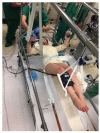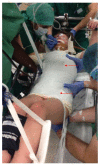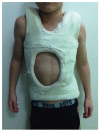Serial elongation-derotation-flexion casting for children with early-onset scoliosis
- PMID: 26716089
- PMCID: PMC4686440
- DOI: 10.5312/wjo.v6.i11.935
Serial elongation-derotation-flexion casting for children with early-onset scoliosis
Abstract
Various early-onset spinal deformities, particularly infantile and juvenile scoliosis (JS), still pose challenges to pediatric orthopedic surgeons. The ideal treatment of these deformities has yet to emerge, as both clinicians and surgeons still face multiple challenges including preservation of thoracic motion, spine and cage, and protection of cardiac and lung growth and function. Elongation-derotation-flexion (EDF) casting is a technique that uses a custom-made thoracolumbar cast based on a three-dimensional correction concept. EDF can control progression of the deformity and - in some cases-coax the initially-curved spine to grow straighter by acting simultaneously in the frontal, sagittal and coronal planes. Here we provide a comprehensive review of how infantile and JS can affect normal spine and thorax and how serial EDF casting can be used to manage these spinal deformities. A fresh review of the literature helps fully understand the principles of the serial EDF casting technique and the effectiveness of conservative treatment in patients with early-onset spinal deformities, particularly infantile and juvenile scolisois.
Keywords: Conservative; Early-onset scoliosis; Elongation-derotation-flexion casting; Infantile scoliosis; Juvenile scoliosis.
Figures






References
-
- Koop SE. Infantile and juvenile idiopathic scoliosis. Orthop Clin North Am. 1988;19:331–337. - PubMed
-
- Nnadi C. Early Onset Scoliosis. Stuttgart, Germany: Thieme; 2015.
-
- Dimeglio A, Bonnel F. Le rachis en croissance. Paris, France: Springer Verlag; 1990.
-
- Canavese F, Dimeglio A, Stebel M, Galeotti M, Canavese B, Cavalli F. Thoracic cage plasticity in prepubertal New Zealand white rabbits submitted to T1-T12 dorsal arthrodesis: computed tomography evaluation, echocardiographic assessment and cardio-pulmonary measurements. Eur Spine J. 2013;22:1101–1112. - PMC - PubMed
Publication types
LinkOut - more resources
Full Text Sources
Other Literature Sources
Miscellaneous

